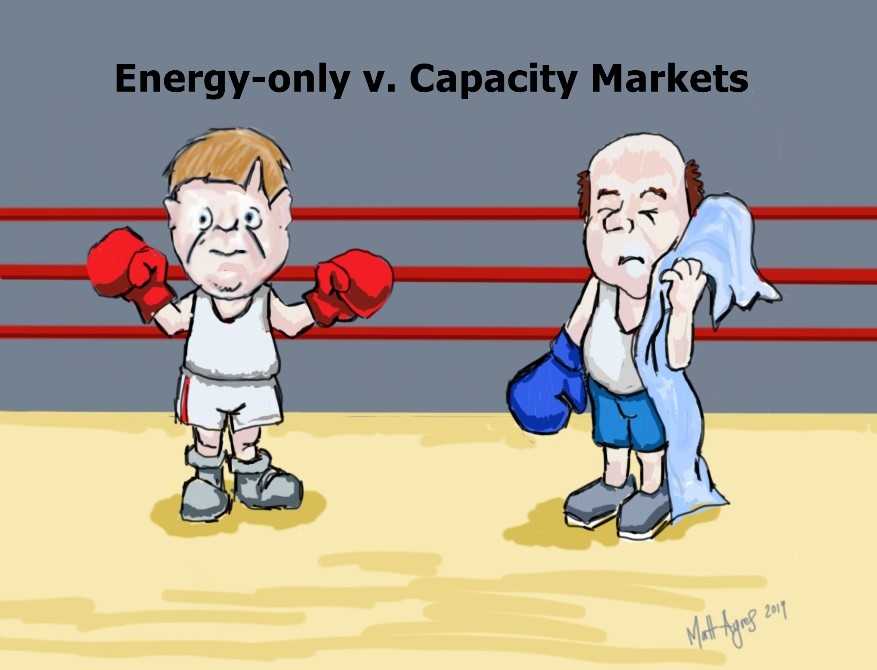Electricity Market Design: Energy-only v. Capacity markets

On July 24, 2019 the Government of Alberta announced an end to plans for Alberta’s electricity market to include a “capacity market” and instead stick with the existing “energy-only” framework that has been in place since 2000. Plans for the capacity market were well advanced with the first capacity auction due next year. The government news release cited the following benefits of maintaining an energy-only market:[1]
- Offers structural and administrative simplicity.
- Has a proven track record for providing affordable electricity in Alberta.
- Has a proven track record for providing a reliable supply of electricity in Alberta.
- Is already established and understood by investors, which offers them greater certainty regarding its future performance.
- Is supported by the majority of electricity stakeholders and consumer groups.
Only a week earlier, Ontario’s Independent Electric System Operator (IESO) announced that it would stop working on its own plans for a capacity market, known as the Incremental Capacity Auction (ICA) citing changed needs for new generating capacity and instead refocus efforts on a Transitional Capacity Auction.
What’s the key difference between energy-only and capacity markets?[2]
Simply put, and not much is simple when dealing with the intricacies of electricity markets, in an energy-only market a producer of electricity is paid only when they actually generate electricity. In capacity markets, an additional stream of revenue is received by producers of electricity who have facilities available during certain times of the year (for example, when demand is high). With this additional stream of revenue there are usually administrative safeguards put in place to ensure that the sum of both energy and capacity revenues is not unreasonable.
If you like simple analogies, you can think of a capacity market as adding a comforting blanket to the energy-only market. Electric system operators may be comforted that enough generation will be available some years in the future and investors may be comforted that some portion of future revenue is secured. A comforting blanket, however, may not be needed and may come at some cost, particularly if you are unsure how much electric generating capacity you might need some years in the future.
Why not capacity markets?
Most jurisdictions in the U.S. that have opted to have electricity markets have done so implementing both energy and capacity markets (the most notable exception being in Texas which remains energy- only). The benefits of capacity markets are usually cited as providing more revenue certainty for investors, providing more certainty about delivering reliable generation and reducing volatility of wholesale prices. While jurisdictions with capacity markets have achieved high levels of reliability and attracted new investment, so too have energy-only markets. Notably in those jurisdictions that have implemented capacity markets the details of the design differ in significant and important ways. Some electricity markets, like the United Kingdom, have tried different versions of both energy-only and capacity market designs only to find problems with each. Alberta had previously considered whether to incorporate a capacity market in 2004 only to reject that and other refinements an maintain a simpler system. A 2017 study commissioned by the Ontario IESO found significant benefits would likely accrue from a move to a capacity market but its not clear whether similar benefits could be found with a move to an alternate structure.
What does it mean for consumers?
In the short-term impacts for consumers appear small. No significant change is now planned in Alberta and in Ontario the implementation of the Incremental Capacity Auction was in any case some years away. Energy-only markets have typically experienced volatility in wholesale prices, but all provide consumers with opportunities to receive long-term stable rates from competitive retailers and, in some cases from regulated retailers as well.
In the medium and longer term all electricity markets face challenges and opportunities posed by new technologies. The maintenance of a simple energy-only framework in Alberta keeps the potential risk and potential reward from choices about which technologies to build primarily with private investors. The Ontario electric system is sometimes described as a hybrid market with many generators supplying electricity under long term contracts and less exposed to market prices. However, even with work ending on the Incremental Capacity Auction, significant work continues on other parts of a broader market renewal program aimed at reducing costs for consumers and providing system efficiencies.
By Matt Ayres, Ph.D.
Dr. Matt Ayres is an Executive Fellow at the School of Public Policy and an Adjunct Assistant Professor in the Department of Economics at the University of Calgary. Matt has over 20 years experience working in a number of electricity markets. Any views expressed are those of the author and not the views of any organisation to which they are affiliated.
[1] Government of Alberta News Release entitled Restoring certainty in the electricity system, July 24, 2019. Available at: https://www.alberta.ca/release.cfm?xID=642387D0ECA3E-ED8E-6B02-885D35312EBBB3EE
[2] The School of Public Policy published a briefing paper in 2018 providing a much more detailed look at the challenges for capacity market design: Brown, David .P. 2018. Capacity Market Design: Motivation and challenges in Alberta’s electricity market, Volume 11:12, SPP Briefing Paper.


